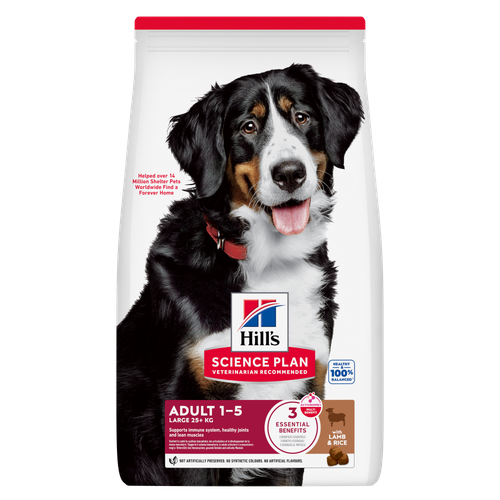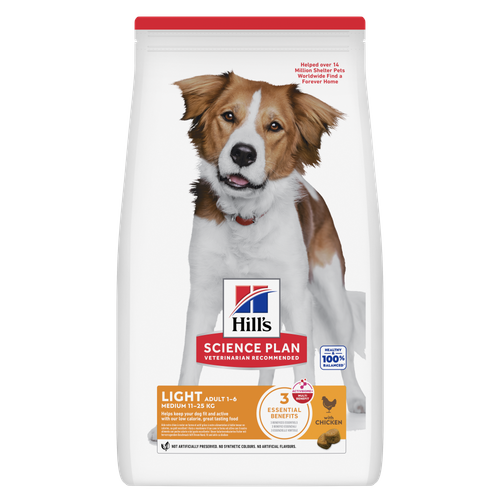
-
Valitut tuotteet
 Light Large Breed Adult koiranruoka
Light Large Breed Adult koiranruokaHill's Science Plan Light Adult Large -koiranruoka kanalla on täysipainoista lemmikinruokaa, joka sisältää ActivBiome+ Multi-Benefit -teknologian.
Se on vähäkalorista ja hyvänmakuista ruokaa, joka auttaa pitämään koirasi kunnossa ja aktiivisena.
Täsmällistä ravintoa vähemmän aktiivisille aikuisille isoille koiraroduille, jotka tarvitsevat vähäkalorista ruokaa terveellisen painon ja elämäntyylin ylläpitämiseen.Osta verkosta Large Breed Adult koiranruoka
Large Breed Adult koiranruokaHill's Science Plan Large Breed Adult -koiranruoka lampaalla ja riisillä on täysipainoista lemmikinruokaa, joka sisältää ActivBiome+ Multi-Benefit -teknologian.
Tämä ruoka on erityisesti suunniteltu täyttämään isojen koirarotujen energiantarpeet heidän parhaassa elämänvaiheessa.Osta verkosta Adult Light koiranruoka
Adult Light koiranruokaHill's Science Plan Light Adult -märkäruoka on ensiluokkaista lemmikin täysravintoa täysikasvuisille koirille, joilla on taipumus lihoa helposti. Tämä herkullinen säilykeruoka on suunniteltu antamaan sopiva määrä energiaa ja tukemaan täysikasvuisten koirien painonhallintaa.
Osta verkostaValitut tuotteet SP -kissanruoka
SP -kissanruokaHill's Science Plan Mature Adult -kissanruoka lohella on täysipainoista lemmikinruokaa, joka sisältää ActivBiome+ Multi-Benefit -teknologian.
Tämä ruoka tukee kissojen arvokasta ikääntymistä tarjoamalla synergisen ainesosaseoksen, joka auttavat antamaan energiaa ja tukemaan aktiivisuutta.Osta nyt SP -kissanruokaOsta nyt
SP -kissanruokaOsta nyt Sterilised -kissanruokaOsta nyt
Sterilised -kissanruokaOsta nyt -
Koiranomistajille
- Vinkit ja artikkelit koiranomistajille
-
Koiran terveyskategoria
- Painonhallinta
- Ruoan ja ympäristön herkkyydet
- Virtsatiet
- Ruoansulatus
- Nivelet
- Munuaiset
-
Koiran elämänvaihe
- Aikuisen ravinto
- Kuntouttava hoito
Kissanomistajille- Vinkit ja artikkelit kissanomistajille
-
Kissan terveyskategoria
- Painonhallinta
- Iho- ja ruoka-aineherkkyydet
- Virtsatiet
- Ruoansulatus
- Munuaiset
-
Kissan elämänvaihe
- Aikuisen ravinto
Valitut artikkelit Uskomaton tiede lemmikkisi mikrobiomin takana
Uskomaton tiede lemmikkisi mikrobiomin takanaOpi, mikä on lemmikin mikrobiomi, miten se vaikuttaa lemmikkisi suolistoon ja yleiseen terveyteen ja miksi ravitsemus on tärkeää terveiden mikrobiomien ylläpitämiselle.
Lue lisää Proteiinit
ProteiinitProteiinit syntyvät, kun aminohapot muodostavat pitkiä aminohappoketjuja. Aminohappoketjuista muodostuu kolmiulotteisia lankavyyhtejä muistuttavia rakenteita.
Lue lisää Märkäruokaa ja rakkautta: märkäruoka on erinomainen vaihtoehto lemmikeille, joilla on ongelmia terveytensä kanssa
Märkäruokaa ja rakkautta: märkäruoka on erinomainen vaihtoehto lemmikeille, joilla on ongelmia terveytensä kanssaOsoita rakkautta märkäruokaan: loistava valinta lemmikkieläimille, joilla on terveysongelmia.
Lue lisää -



Like great nutrition and a loving home, playtime is essential to your dog's well-being.
It provides exercise, stimulation, fun and superb interaction. And playtime is especially important if your pet spends extended periods alone. Sometimes pets can't stand to be separated from their owners, and it shows in their unhappiness and possibly destructive behaviour.
If this is the case, provide your dog plenty of attention to help compensate for your absence.
Simple games
You'll be surprised at how the simplest game can be a fun experience for your dog. Chase is one of those games that dogs love. They have fun chasing a tennis ball, a Frisbee, a stick or a stuffed toy, especially one that squeaks. Maybe your dog likes chasing a soccer ball and pushing it back with his nose. Or maybe he simply wants to chase you.
The chase game also works well with water, depending on the breed and your dog's ease with water.
If a ball is used as the toy, be wary of the size. Ensure it is small enough that he can pick it up with his mouth, but not so small that he may swallow it. Also, limit the number of toys to a few favourites. Having too many toys often confuses dogs about what is a toy and what is not.
More playful activities
You might want to try a problem-solving game with your dog. Place a treat inside a cardboard box and let your dog work at finding it. At first, use a box that allows for easy access to the treat, and as he is successful, switch to a more complex box. Of course, afterwards you'll probably have parts of shredded cardboard to pick up.


Maukkaat vinkit
Pennut saattavat tarvita useita käyntejä ensimmäisenä vuonna rokotuksia varten. Aikuiset koirat hyötyvät yleensä vuosittaisista tarkastuksista, kun taas vanhemmat tai erityistarpeita tarvitsevat koirat saattavat tarvita useammin käyntejä.
Dogs also enjoy hide-and-seek. Initially, make it easy. Hide a treat in another room but make it obvious. Let your dog in the room. Compliment him when he finds the treat and give him a reward. The game can be played inside or outside.
You can also play if you don't mind acting silly. Get on your hands and knees as close to your dog as possible. Bend your elbows and lower head and do your best barking impression. Your dog will tip his head and give you an awkward look. Bark again and he might bark back. Run a few steps and turn back towards your dog, get down and bark again. Repeat the process. Your dog will catch on, and it will turn into a playful activity.
Keep in mind your dog's play companion doesn't have to be you. A social dog will enjoy meeting and playing with other dogs. This includes wrestling, frolicking, running in the open spaces and exploring.
Playtime tips
- If you are leaving your puppy or dog alone for a while, walk or play with him in advance of leaving so he has a chance to expend excess energy.
- Training can be a game. You can teach a dog to come to you when called. Dogs learn tricks because they are a game to them.
- Don't use personal or household objects as toys. Dogs can't recognize the difference between your old sneakers and those new shoes you bought last week.
- Make an effort to commit to your dog's needs, including playtime. If you can't do it alone, ask a friend or family member to help.
Don't underestimate the power of attention and playtime. Stimulation lets your dog burn excess energy and helps calm nerves and emotions. The result will be a happy, fun-loving dog.


Yksi henkilökunnan kirjoittajistamme valmisteli tämän artikkelin sinulle
Aiheeseen liittyvät tuotteet

Hill's Science Plan Light Adult Large -koiranruoka kanalla on täysipainoista lemmikinruokaa, joka sisältää ActivBiome+ Multi-Benefit -teknologian.
Se on vähäkalorista ja hyvänmakuista ruokaa, joka auttaa pitämään koirasi kunnossa ja aktiivisena.
Täsmällistä ravintoa vähemmän aktiivisille aikuisille isoille koiraroduille, jotka tarvitsevat vähäkalorista ruokaa terveellisen painon ja elämäntyylin ylläpitämiseen.

Hill's Science Plan Large Breed Adult -koiranruoka lampaalla ja riisillä on täysipainoista lemmikinruokaa, joka sisältää ActivBiome+ Multi-Benefit -teknologian.
Tämä ruoka on erityisesti suunniteltu täyttämään isojen koirarotujen energiantarpeet heidän parhaassa elämänvaiheessa.

Hill's Science Plan Light Adult -märkäruoka on ensiluokkaista lemmikin täysravintoa täysikasvuisille koirille, joilla on taipumus lihoa helposti. Tämä herkullinen säilykeruoka on suunniteltu antamaan sopiva määrä energiaa ja tukemaan täysikasvuisten koirien painonhallintaa.

Hill's Science Plan Light Adult Medium -koiranruoka kanalla on täysipainoista lemmikinruokaa, joka sisältää ActivBiome+ Multi-Benefit -teknologian.
Se on vähäkalorista ja hyvänmakuista ruokaa, joka auttaa pitämään koirasi kunnossa ja aktiivisena.
Täsmällistä ravintoa vähemmän aktiivisille aikuisille keskikokoisille koiraroduille, jotka tarvitsevat vähäkalorista ruokaa terveellisen painon ja elämäntyylin ylläpitämiseen.
Aiheeseen liittyvät artikkelit
Tutustu koirien munuaissairauden syihin, oireisiin ja hoitoihin ja löydä keinoja koirasi munuaisten terveyden tukemiseen. Lue lisää Hill's Petiltä.

Tutustu labradorinnoutajasi kyltymättömän ruokahalun taustalla olevaan tutkimukseen ja siihen, mistä se voi johtua. Lue lisää lemmikkisi ravitsemustarpeista Hill's Petiltä.

Selvitä parhaat menetelmät koiran punnitsemiseen kotona ilman erikoisvälineitä. Hill's Petiltä löydät lisää vinkkejä koirasi terveyden ylläpitämiseksi.

Ymmärrä koiran liiallisen kutinan mahdolliset syyt ja miten niihin puututaan. Etsi helpotusta koirallesi Hill's Pet UK:n asiantuntijoiden neuvojen avulla.

Laita koirasi dieetille ilman että se huomaa
Vähäkalorinen koostumuksemme auttaa hallitsemaan koirasi painoa. Se sisältää runsaasti korkealaatuista proteiinia lihasmassan rakentamiseen ja on valmistettu huolella valituista ainesosista maukkaaksi ja ravitsevaksi ateriaksi. Kliinisesti tutkitut antioksidantit, C- ja E-vitamiini, tukevat tervettä immuunijärjestelmää.
Laita koirasi dieetille ilman että se huomaa
Vähäkalorinen koostumuksemme auttaa hallitsemaan koirasi painoa. Se sisältää runsaasti korkealaatuista proteiinia lihasmassan rakentamiseen ja on valmistettu huolella valituista ainesosista maukkaaksi ja ravitsevaksi ateriaksi. Kliinisesti tutkitut antioksidantit, C- ja E-vitamiini, tukevat tervettä immuunijärjestelmää.

